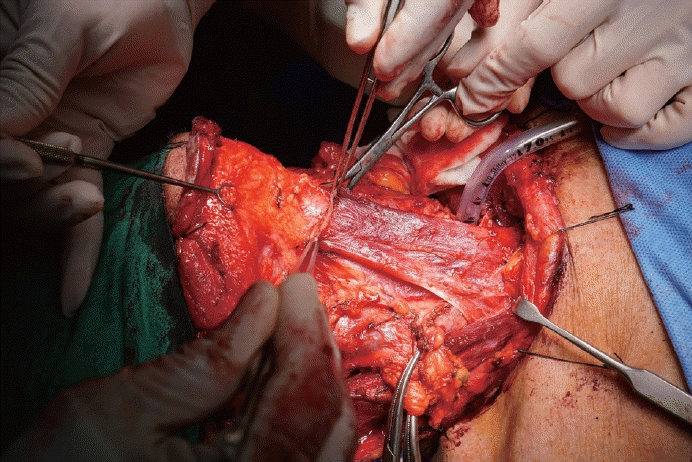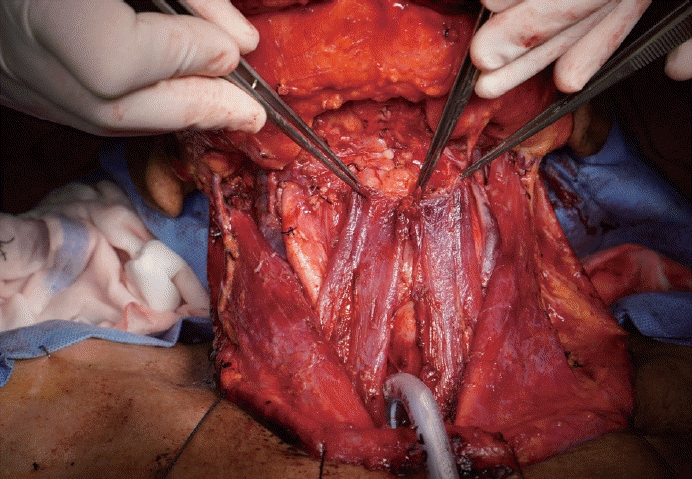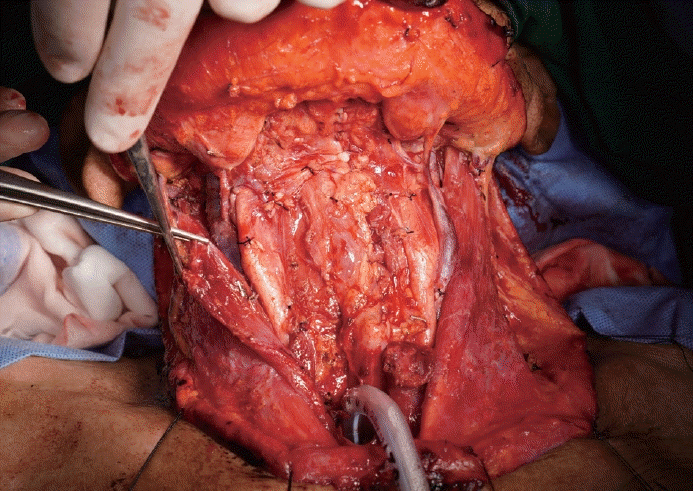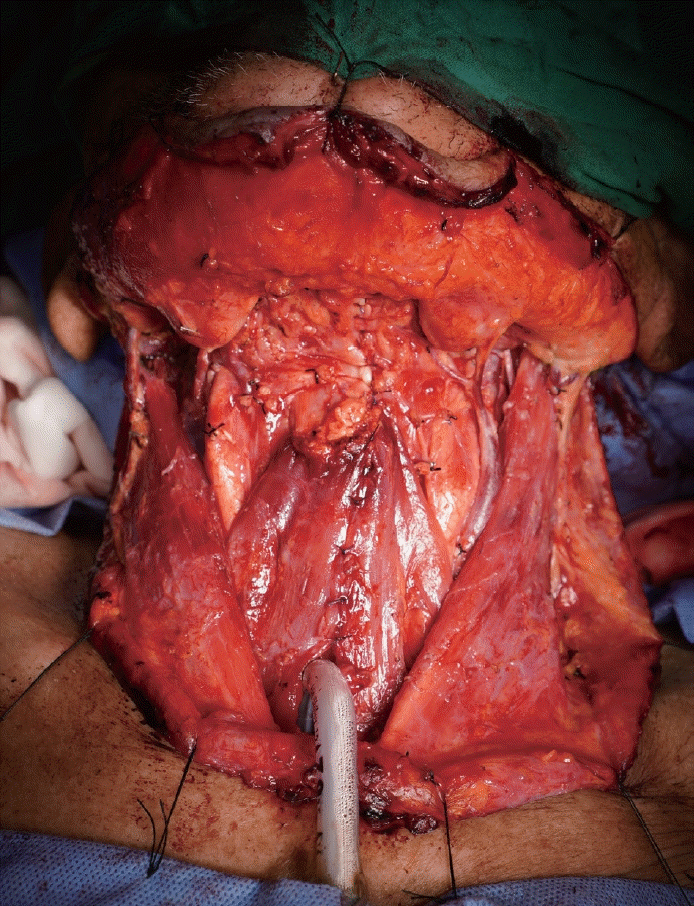후두 전적출술 후 흉골설골근과 견갑설골근을 이용한 인두 봉합 강화술
Pharyngeal Closure Reinforced With Sternohyoid and Omohyoid Muscle After Total Laryngectomy
Article information
Trans Abstract
Pharyngocutaneous fistula occurring after total laryngectomy is a bothersome complication as it can even cause a massive bleeding due to carotid artery rupture. Preoperative radiation, extensive diseases which need flap reconstruction, low albumin or hemoglobin level, history of smoking, or underlying diseases have been domestically reported to have a relationship with the condition. To reduce this complication, simultaneous coverage for the pharyngeal closure has been developed using flaps, such as the pectoralis major muscle, the radial forearm or the anterolateral thigh, which are distant from the radiation field. However, these methods need additional surgical techniques and times. Another method advocated is pharyngeal reinforcement using flaps that can be easily obtained from the same surgical field, such as the sternocleidomastoid or the infrahyoid muscle or the acellular dermal graft with relative significances. Here we suggest reinforcement of pharyngeal closure after total laryngectomy using the sternohyoid and omohyoid muscle flaps.
서 론
인두피부누공은 후두 전적출술 후 봉합된 인두에 열개가 생기면서 구강 및 인두액이 심경부에 고인 후 피부로 흘러 나오는 상태로, 경동맥 파열과 같은 치명적인 결과를 초래할 수 있는 합병증이다[1,2]. 원인에 대한 국내보고로는 술전 방사선 치료[3,4], 인두재건술이 필요할 정도의 광범위 질환[3-5], 저하된 알부민 수치[5,6], 혹은 저하된 헤모글로빈 수치나 흡연 및 기저질환[6] 등이 있다.
이를 예방하기 위해 두경부 방사선 범위에서 좀 떨어진 곳의 피판, 즉 대흉근피판[7-9]이나 요측 전완이나 전외측 대퇴 유리 피판[10]을 이용하여 인두 봉합을 강화하는 방법이 제시되고 연구되었다. 그러나 이러한 방법들은 수술 시간의 연장과 피판 수술에 관련된 기술과 합병증 등의 문제점이 있다. 다른 연구자들은 같은 수술 구역에서 쉽게 얻을 수 있는 흉쇄유돌근피판[11]이나 설골하부 근막 피막[12], 혹은 상품화된 무세포 진피 이식[13]으로 인두 봉합을 강화하는 것을 제안하였다.
이에 본 연구자는 통상적인 후두 전적출술 때는 절제되는 흉골설골근과 견갑설골근을 이용하여 인두 봉합을 강화해 보고자 하였다.
방 법
견갑설골근 및 흉골설골근의 분리(isolation of the omohyoid and sternohyoid muscle)
피부 절개와 광경근의 하부로 피판을 거상한 후(subplatysmal flap elevation), 일측의 경부에서 견갑설골근과 흉골설골근의 근막 표층에 붙어 있는 연부 조직들을 근막을 보존하면서 떼어내어 정리한다. 이렇게 하여 근육의 파열을 최소화해서 향후 봉합에 용이하게 한다. 이때 가능하다면 두 근육의 사이는 박리하지 않고 두 근육이 한 단위로 이용될 수 있게 한다. 설골하부 피대근(strap muscle)은 상갑상선동맥(superior thyroid artery), 하갑상선동맥(inferior thyroid artery), 내흉동맥(internal mammary artery)의 세 혈관을 통해 혈류 공급을 받고 있다. 견갑설골근과 흉골설골근의 주변을 박리할 때 상갑상선동맥은 결찰하고, 하갑상선동맥과 내흉동맥을 통해 혈류 공급을 받는 부위는 보존되도록 정리한다(Fig. 1 and Supplementary Video 1).

The right side of omohyoid and sternohyoid muscles are isolated together as one unit from the surrounding soft tissue.
하부기저 피판 만들기(making inferiorly-based flap by cutting the insertion at the hyoid bone and freeing)
두 근육이 부착(insertion)되어 있는 설골의 하연에서 두 근육을 조심스럽게 분리한 후 하부기저 피판이 되게 밑면을 정리하여 자유롭게 한다(Fig. 2 and Supplementary Video 1).
반대편에서 동일 시술 시행(same procedure at the other side)
같은 절차를 반대편에서도 시행하여 양측의 근육이 이용될 수 있게 한다(Fig. 3 and Supplementary Video 1).
후두 전적출술 및 인두 봉합 (pharyngeal closure after total laryngectomy)
후두 전적출술을 시행한 후 구인두 및 하인두의 조직이 일차 봉합이 가능할 정도로 충분이 여유가 있다면 인두의 일차 봉합을 시행한다(Figs. 4, 5, and Supplementary Video 1).
인두 봉합 강화술(reinforcement of pharyngeal closure with bilateral sternohyoid and omohyoid muscle flap)
인두의 일차 봉합의 전벽을 강화하기 위해 준비해 둔 양측의 견갑설골근과 흉골설골근 피판을 기관절개술의 기공을 덮지 않도록 하면서 봉합된 전벽의 조직에 여러 번 고정(anchoring)시킨 후 양측 근육 피판을 밀착시키는 봉합을 시행한다. 경우에 따라서 인두 봉합 전체에 적용되거나 식도 문합 부위 중심으로 적용될 수 있겠다(Fig. 6 and Supplementary Video 1).
결 과
후두 전적출술 후 인두봉합을 시행한 후 향후에 발생할 수 있는 인두피부누공 등의 합병증을 예방하기 위해, 하부기저의 견갑설골근과 흉골설골근의 피판을 이용하여 인두봉합을 강화하는 것은 같은 수술 구역에서 쉽게 얻을 수 있으며 특별한 기술들이 필요하지 않는 유용한 술식이다. 다만 암종이 후두 골격을 침범하여 뚫고 나와 피대근을 침범하지 않은 환자에서 시행될 수 있겠다.
본 연구 기관에서의 경험은 아직 시행 초기 단계(술전 치료 과거력이 없는 수술 2예, 술전 항암방사선 치료 후 구제수술 1예)로서 어느 정도의 누공의 예방 효과는 있어 보이나, 확정적인 결론에 이르기에는 많은 증례들의 분석이 필요할 것이며 추후 연구를 진행하고자 한다.
Naghibzadeh 등[11]은 흉쇄유돌근 피판을 이용하여 37명 중 1예(2.7%)의 누공율을 보고하였고, Kadota 등[12]은 본 증례와 완전히 같지는 않지만 비슷한 방법의 설골하부 근막피판을 사용하여 11명 중의 2예(18.2%)의 누공율을 보고하였다. 흉쇄유돌근은 더 두꺼워서 인두 봉합을 더 강화시켜 줄 것으로 예상되지만, 흉쇄유돌근 소실로 인한 경동정맥의 노출과 경부 움직임의 제한이 있겠다. 견갑설골근과 흉골설골근을 이용하는 경우에는 후두 전적출술 때는 통상적으로는 제거되는 조직을 강화술에 이용하는 장점이 있으며, 흉쇄유돌근을 보존하기 때문에 경부 대혈관도 보호하고 경부 움직임도 큰 제한이 없겠다.
Supplementary Materials
The Data Supplement is available with this article at https://doi.org/10.3342/kjorl-hns.2022.00416.
Acknowledgements
None
Notes
Author Contribution
Conceptualization: Joon Kyoo Lee. Methodology: Eun Kyung Jung, Joon Kyoo Lee. Resources: Keon Woo Park, Hye-Bin Jang. Writing—original draft: Keon Woo Park. Writing—review & editing: Joon Kyoo Lee.





